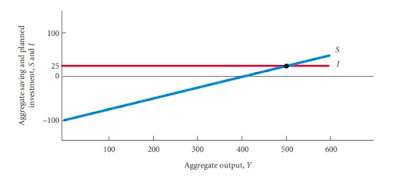The Saving/Investment Approach to Equilibrium Because aggregate income must be saved or spent, by definition, Y =C + S, which is an identity. The equilibrium condition is Y = C + I, but this is not an identity because it does not hold when we are out of equilibrium. By substituting C + S for Y in the equilibrium condition, we can write: C + S = C + I Because we can subtract C from both sides of this equation, we are left with: S = I Thus, only when planned investment equals saving will there be equilibrium. Notice that S = I at one and only one level of aggregate output, Y = 500. At Y = 500, C = 475 and I = 25. In other words, Y = C + I; therefore, equilibrium exists. The S = I Approach to Equilibrium Aggregate output is equal to planned aggregate expenditure only when saving equals planned investment (S = I). Saving and planned investment are equal at Y = 500. Adjustment to Equilibrium We will learned how firms might react to disequilibrium. Let us consider the ...







